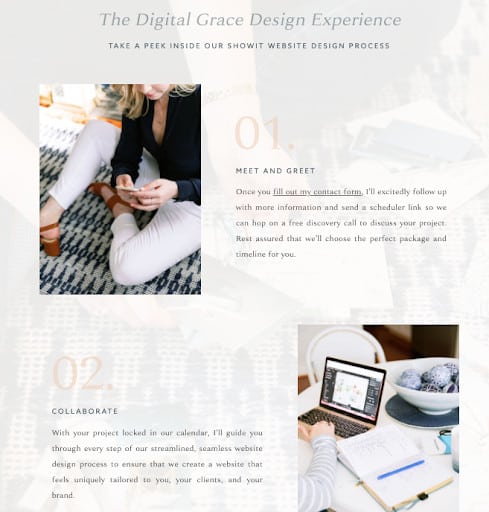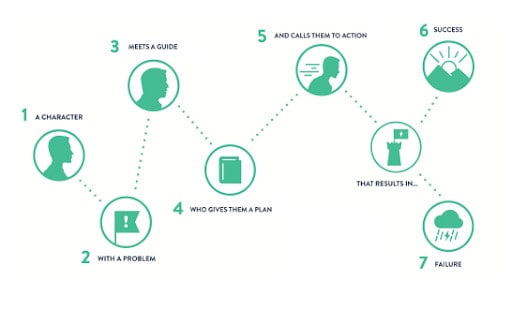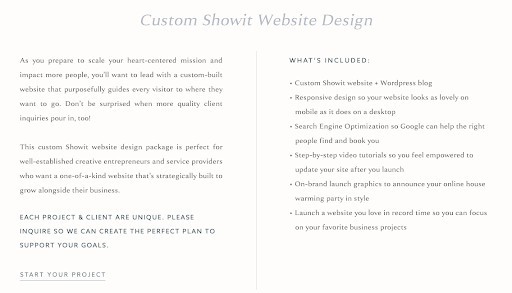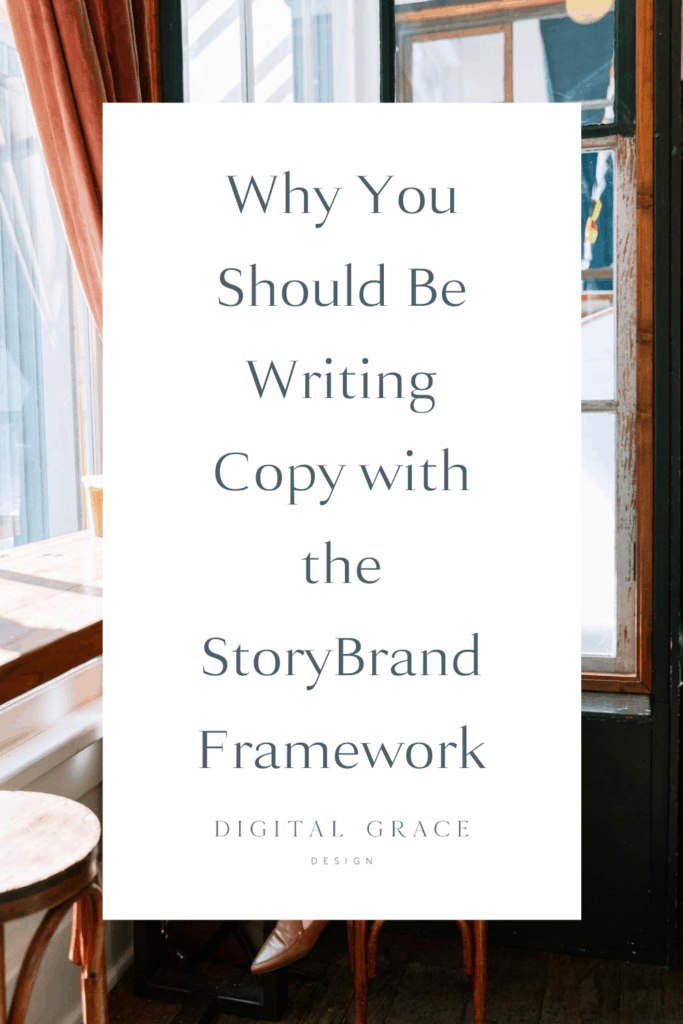Raise your hand if you’ve ever said, “I wish this copy would just write itself.”
That’s how many of my clients feel when they’re in the middle of writing. It’s easy to start with a optimistic spirit, but as you get deeper and deeper into the process, you might lose steam when you encounter writing challenges.
One of the biggest reasons why entrepreneurs feel tripped up while writing copy is because they don’t know how to speak to their ideal customer. Sometimes they might not even know who they want to work with!
It’s hard to write when you don’t know who the message is directed to.
Luckily for us, the StoryBrand framework is here to help.
Combining the best practices of tried-and-true narrative storytelling, copywriting, and modern marketing, this framework gives you the foundation you need to write better copy for any platform.
While the StoryBrand framework was developed by Donald Miller, a non-fiction writer turned messaging educator, much of it was inspired by the infamous “hero’s journey.”
I believe in the framework so much that I became a Certified StoryBrand Guide years ago. I recommend the framework to all of my website design clients, and this article is all about why I recommend it to you, too!
Let’s begin with the most obvious reason why you’ll love the StoryBrand framework.
It shifts the attention to your client
When I ask my clients to provide content for their website, most of them get stuck on their About page or while writing their professional bio.
I get it! Sometimes the thought of writing about ourselves can be downright paralyzing. When you feel too close to your own business, it’s easy to get inside your head and overthink everything you write.
Luckily, with StoryBrand, the focus is on your client or customer, not your own brand. That way, your audience member is strategically positioned as the “hero” of the story. Your brand simply becomes the “guide” that gets them from Point A to Point B (and even further).
When a visitor lands on your website, remember that while they want to learn about you, they mostly want to know how you can help THEM. They want to see that you deeply understand their motivations, habits, strengths, and weaknesses. Only then will they take your solutions seriously.
This is a better approach to copywriting and marketing because it takes the pressure off of you to write perfectly about yourself. Instead, you’ll be able to focus your content on the different ways your products and services can benefit your clients or customers. In the end, it’s all about them!
You’ll write in a more clear and concise way
When you have an expertise in something, it can be a struggle to simplify your explanation of exactly what you do.
You may think that by making your offers seem more complex, it will encourage your client to hire an expert rather than trying to figure it out on their own, but it rarely works that way. I get the logic behind that reasoning, but when we test that approach, it doesn’t win.
Instead, it’s been proven that the clearer your message is, the quicker your audience is able to digest it. That means your audience doesn’t have to do mental gymnastics to understand what you’re selling. This can increase your conversions because your audience will spend less time in the consideration phase of the customer journey.
It also takes away any feelings of analysis paralysis which can produce overwhelming emotions when our clients have too many options to choose from.
Since the StoryBrand framework is focused on simplifying the buying process, your copywriting will naturally improve because you’ll only write about the details that matter. It’s a great exercise in cutting the unnecessary “fluff” from your writing so all that remains is the good stuff. (Yeah, I’m looking at you, complex jargon and word vomits!)
It gives your customers an intuitive process to follow
Think about the last time you made an investment in your business. Maybe it was hiring a business coach, a new team member, or even purchasing a ticket to an in-person retreat. (Since I’m writing this during the COVID pandemic, I’m dreaming about that right now!)
No matter what you invested in, I’m willing to bet you made sure to look into the process before moving forward. That’s because we want to avoid feeling stuck when the process actually begins. It’s easier to know what the 1-2-3 steps look like before making the investment decision so we can feel confident in our purchase.
By emphasizing your process and making it super simple to understand, you give your audience a clear idea of what it looks like to take them from where they currently are to where they want to go. This is your role as the “guide,” so laying out the most simplified version of your process is so important.
For example, my client Carolyn Teague did a fantastic job of showing the step-by-step process it takes to book a virtual consult.

I believe in the power of processes so much that I also highlight my process on my Services page. Although there are a few key phases in every website design project, I tried to make it as simple as possible.

I’ve also noticed that I get fewer questions to answer from potential clients about my process since putting it on my website, so it’s easier to book more projects in less time. I’m all about that!
Simply put, let your visitors know what to expect from your process before they dive into it. Then they’ll feel more confident in working with you or buying from you.
It’s incredibly easy to customize to your business
Have you ever felt like it would be easier to write if you had someone telling you how to organize your thoughts? The StoryBrand Framework can totally help you out with that.
They break down their storytelling process into seven crucial steps:
- We introduce a character as the hero.
- Then, we identify what their key problem is.
- Our hero is ready to meet the guide (that’s you!).
- The guide gives them a plan on how to move forward.
- The guide inspires the hero to take action.
- We see ways that the hero finds success…
- And we notice how they can learn from failures.

This cycle keeps repeating for every customer lead you interact with. When someone lands on your website or interacts with you on social media, you’ll typically find yourself in step three. Step four happens once they hire you and you work together on a strategy.
But wait… how do you get to step three and four?
Well, you’ll need your copywriting to address step one and two.
Let’s break it down in simple terms. This means all of the words on your website, social media, emails, and other platforms need to show that you understand (a) who your audience is, (b) what they are currently struggling with, (c) why you are the perfect person or brand to help them overcome the obstacle.
Not too complicated, right? Anytime I work with a client on their copywriting (since it is an add-on service for us at DGD) or write my own brand copy, I revisit this storytelling framework and it always helps me clarify and simplify.
It’s focused on values and emotions
We all know you need to build trust with customers before they even think about making a purchase, but how do you build that initial trust? Through your copywriting, of course! This means you need to craft your messaging in a way that speaks to your audience’s core values.
Sometimes as service providers, we get wrapped up in the tangible deliverables. While those are important, clients are also coming to us to solve a greater, deeper problem in their business.
For example, a wedding planner can help you find the right vendors, choose a stunning venue, and plan your wedding day timeline, but they do SO much more than that. The experience they really provide is a stress-free wedding so you can be present on your big day.
See what I mean? That’s why StoryBrand teaches you to lead with the benefits rather than the features of your offer, like I did on my Services page.
Benefits (under the “Our Solution Together” headline)

Features (further down the page)

It’s more important for a visitor to know how your services can help them than exactly what your packages include. Features like one-on-one strategy calls and unlimited email communication are still important to highlight, but they don’t need to be front-and-center on your website.
Psst… you’ll want to remember this whenever you are trying to sell something through social media posts or emails, too!
StoryBrand is a copywriting framework that works
You can use StoryBrand to create better copy for virtually any platform. Use it in your marketing materials, PDF guides, lead magnets, website, social media, email marketing, anything!
Before you write a word of copy, remember the steps you’ve outlined in your BrandScript from StoryBrand. If you haven’t had a chance to create your own yet, click here to get started for free.
Do you need a little more convincing? I’ve got a great story that illustrates just how effective this framework is. JJ, who works at StoryBrand, did his PhD on the StoryBrand Framework to study when it works, why it does, and what kind of businesses are best for it.
He found that it worked 100% of the time as long as the steps were implemented fully. When it fails, it’s usually because the brand hasn’t taken the time to completely follow their process.
If you are planning to write your own copy, be sure to read through their blog archive and listen to their podcast episodes for more information.
If you’re looking for a done-for-you service with a copywriter who follows the framework, look no further – I’m your gal! Let’s chat about your project.
